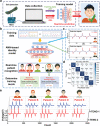Wearable Triboelectric Sensors Enabled Gait Analysis and Waist Motion Capture for IoT-Based Smart Healthcare Applications
- PMID: 34796695
- PMCID: PMC8811828
- DOI: 10.1002/advs.202103694
Wearable Triboelectric Sensors Enabled Gait Analysis and Waist Motion Capture for IoT-Based Smart Healthcare Applications
Abstract
Gait and waist motions always contain massive personnel information and it is feasible to extract these data via wearable electronics for identification and healthcare based on the Internet of Things (IoT). There also remains a demand to develop a cost-effective human-machine interface to enhance the immersion during the long-term rehabilitation. Meanwhile, triboelectric nanogenerator (TENG) revealing its merits in both wearable electronics and IoT tends to be a possible solution. Herein, the authors present wearable TENG-based devices for gait analysis and waist motion capture to enhance the intelligence and performance of the lower-limb and waist rehabilitation. Four triboelectric sensors are equidistantly sewed onto a fabric belt to recognize the waist motion, enabling the real-time robotic manipulation and virtual game for immersion-enhanced waist training. The insole equipped with two TENG sensors is designed for walking status detection and a 98.4% identification accuracy for five different humans aiming at rehabilitation plan selection is achieved by leveraging machine learning technology to further analyze the signals. Through a lower-limb rehabilitation robot, the authors demonstrate that the sensory system performs well in user recognition, motion monitoring, as well as robot and gaming-aided training, showing its potential in IoT-based smart healthcare applications.
Keywords: human-machine interface; machine learning; robot-aided rehabilitation; smart healthcare; triboelectric sensors.
© 2021 The Authors. Advanced Science published by Wiley-VCH GmbH.
Conflict of interest statement
The authors declare no conflict of interest.
Figures






Similar articles
-
A Systematic Approach to the Design and Characterization of A Smart Insole for Detecting Vertical Ground Reaction Force (vGRF) in Gait Analysis.Sensors (Basel). 2020 Feb 11;20(4):957. doi: 10.3390/s20040957. Sensors (Basel). 2020. PMID: 32053914 Free PMC article.
-
Triboelectric nanogenerators as new energy technology for self-powered systems and as active mechanical and chemical sensors.ACS Nano. 2013 Nov 26;7(11):9533-57. doi: 10.1021/nn404614z. Epub 2013 Oct 3. ACS Nano. 2013. PMID: 24079963
-
Wearable biosensors for real-time sweat analysis and body motion capture based on stretchable fiber-based triboelectric nanogenerators.Biosens Bioelectron. 2022 Jun 1;205:114115. doi: 10.1016/j.bios.2022.114115. Epub 2022 Feb 21. Biosens Bioelectron. 2022. PMID: 35219020
-
Triboelectric Nanogenerator-Based Sensor Systems for Chemical or Biological Detection.Adv Mater. 2021 Sep;33(35):e2008276. doi: 10.1002/adma.202008276. Epub 2021 Jul 9. Adv Mater. 2021. PMID: 34245059 Review.
-
Advances in Smart Sensing and Medical Electronics by Self-Powered Sensors Based on Triboelectric Nanogenerators.Micromachines (Basel). 2021 Jun 15;12(6):698. doi: 10.3390/mi12060698. Micromachines (Basel). 2021. PMID: 34203757 Free PMC article. Review.
Cited by
-
An Energy Harvester Coupled with a Triboelectric Mechanism and Electrostatic Mechanism for Biomechanical Energy Harvesting.Nanomaterials (Basel). 2022 Mar 11;12(6):933. doi: 10.3390/nano12060933. Nanomaterials (Basel). 2022. PMID: 35335744 Free PMC article.
-
Application Effect of Motion Capture Technology in Basketball Resistance Training and Shooting Hit Rate in Immersive Virtual Reality Environment.Comput Intell Neurosci. 2022 Jun 24;2022:4584980. doi: 10.1155/2022/4584980. eCollection 2022. Comput Intell Neurosci. 2022. PMID: 35785072 Free PMC article.
-
AI-Driven TENGs for Self-Powered Smart Sensors and Intelligent Devices.Adv Sci (Weinh). 2025 May;12(20):e2417414. doi: 10.1002/advs.202417414. Epub 2025 Apr 25. Adv Sci (Weinh). 2025. PMID: 40277838 Free PMC article. Review.
-
Interpretable evaluation for the Brunnstrom recovery stage of the lower limb based on wearable sensors.Front Neuroinform. 2022 Sep 8;16:1006494. doi: 10.3389/fninf.2022.1006494. eCollection 2022. Front Neuroinform. 2022. PMID: 36156985 Free PMC article.
-
Recent Advances in Self-Powered Wearable Flexible Sensors for Human Gaits Analysis.Nanomaterials (Basel). 2024 Jul 10;14(14):1173. doi: 10.3390/nano14141173. Nanomaterials (Basel). 2024. PMID: 39057851 Free PMC article. Review.
References
-
- Shi Q., Dong B., He T., Sun Z., Zhu J., Zhang Z., Lee C., InfoMat 2020, 2, 1131.
-
- Cho Y., Pak S., Lee Y. G., Hwang J. S., Giraud P., An G. H., Cha S. N., Adv. Funct. Mater. 2020, 30, 1908479.
-
- Wang S., Fang Y., He H., Zhang L., Li C., Ouyang J., Adv. Funct. Mater. 2021, 31, 2007495.
-
- Zhang Q., Li L., Wang T., Jiang Y., Tian Y., Jin T., Yue T., Lee C., Nano Energy 2021, 90, 106501.
Publication types
MeSH terms
Grants and funding
LinkOut - more resources
Full Text Sources
Other Literature Sources
